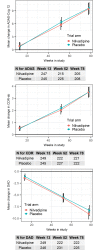Nilvadipine in mild to moderate Alzheimer disease: A randomised controlled trial
- PMID: 30248105
- PMCID: PMC6152871
- DOI: 10.1371/journal.pmed.1002660
Nilvadipine in mild to moderate Alzheimer disease: A randomised controlled trial
Abstract
Background: This study reports the findings of the first large-scale Phase III investigator-driven clinical trial to slow the rate of cognitive decline in Alzheimer disease with a dihydropyridine (DHP) calcium channel blocker, nilvadipine. Nilvadipine, licensed to treat hypertension, reduces amyloid production, increases regional cerebral blood flow, and has demonstrated anti-inflammatory and anti-tau activity in preclinical studies, properties that could have disease-modifying effects for Alzheimer disease. We aimed to determine if nilvadipine was effective in slowing cognitive decline in subjects with mild to moderate Alzheimer disease.
Methods and findings: NILVAD was an 18-month, randomised, placebo-controlled, double-blind trial that randomised participants between 15 May 2013 and 13 April 2015. The study was conducted at 23 academic centres in nine European countries. Of 577 participants screened, 511 were eligible and were randomised (258 to placebo, 253 to nilvadipine). Participants took a trial treatment capsule once a day after breakfast for 78 weeks. Participants were aged >50 years, meeting National Institute of Neurological and Communicative Disorders and Stroke/Alzheimer's disease Criteria (NINCDS-ADRDA) for diagnosis of probable Alzheimer disease, with a Standardised Mini-Mental State Examination (SMMSE) score of ≥12 and <27. Participants were randomly assigned to 8 mg sustained-release nilvadipine or matched placebo. The a priori defined primary outcome was progression on the Alzheimer's Disease Assessment Scale Cognitive Subscale-12 (ADAS-Cog 12) in the modified intention-to-treat (mITT) population (n = 498), with the Clinical Dementia Rating Scale sum of boxes (CDR-sb) as a gated co-primary outcome, eligible to be promoted to primary end point conditional on a significant effect on the ADAS-Cog 12. The analysis set had a mean age of 73 years and was 62% female. Baseline demographic and Alzheimer disease-specific characteristics were similar between treatment groups, with reported mean of 1.7 years since diagnosis and mean SMMSE of 20.4. The prespecified primary analyses failed to show any treatment benefit for nilvadipine on the co-primary outcome (p = 0.465). Decline from baseline in ADAS-Cog 12 on placebo was 0.79 (95% CI, -0.07-1.64) at 13 weeks, 6.41 (5.33-7.49) at 52 weeks, and 9.63 (8.33-10.93) at 78 weeks and on nilvadipine was 0.88 (0.02-1.74) at 13 weeks, 5.75 (4.66-6.85) at 52 weeks, and 9.41 (8.09-10.73) at 78 weeks. Exploratory analyses of the planned secondary outcomes showed no substantial effects, including on the CDR-sb or the Disability Assessment for Dementia. Nilvadipine appeared to be safe and well tolerated. Mortality was similar between groups (3 on nilvadipine, 4 on placebo); higher counts of adverse events (AEs) on nilvadipine (1,129 versus 1,030), and serious adverse events (SAEs; 146 versus 101), were observed. There were 14 withdrawals because of AEs. Major limitations of this study were that subjects had established dementia and the likelihood that non-Alzheimer subjects were included because of the lack of biomarker confirmation of the presence of brain amyloid.
Conclusions: The results do not suggest benefit of nilvadipine as a treatment in a population spanning mild to moderate Alzheimer disease.
Trial registration: Clinicaltrials.gov NCT02017340, EudraCT number 2012-002764-27.
Conflict of interest statement
I have read the journal's policy and the authors of this manuscript have the following competing interests: SH is a paid employee of Pentara Corporation, which received payment to verify the primary outcome analysis of this study, and is also a paid consultant for Acumen Pharmaceuticals, Affiris AG, Affirmativ Diagnostics PLLC, Alkahest, Allergan, Alzheon, Amylyx Pharmaceuticals, Apodemus, Avanir Pharmaceuticals, Banner Alzheimer's Institute, Biogen, Dr. Richard Isaacson, Gerson Lehrman Group, Grifols Shared Services North America, Ionis Pharmaceuticals, M3 Biotechnology, Neurotrope BioScience, Nutricia Research B.V., PhotoPharmics, Regenera Pharma, Roche (F. Hoffmann-La Roche--Switzerland), Toyama Chemical Co., and vTv Therapeutics; MM and FC are paid employees of Archer Pharmaceuticals, which owns patents for the use of nilvadipine in Alzheimer disease; MM, FC, SK, RS, and BL are named as inventors in a pending patent for the use of nilvadipine based on the results of this clinical trial. No other authors have declared competing interests.
Figures


References
-
- Rouch L, Cestac P, Hanon O, Cool C, Helmer C, Bouhanick B, et al. Antihypertensive drugs, prevention of cognitive decline and dementia: a systematic review of observational studies, randomized controlled trials and meta-analyses, with discussion of potential mechanisms. CNS Drugs. 2015. Feb; 29(2):113–130. 10.1007/s40263-015-0230-6 - DOI - PubMed
Publication types
MeSH terms
Substances
Associated data
LinkOut - more resources
Full Text Sources
Other Literature Sources
Medical
Miscellaneous

